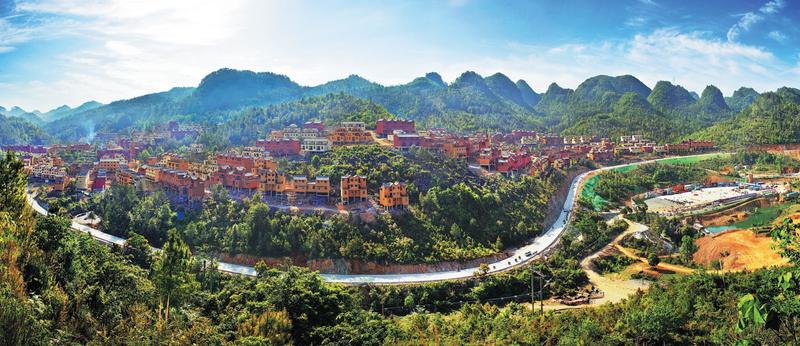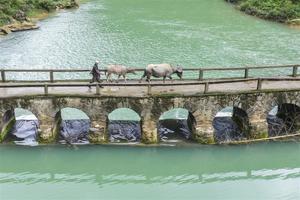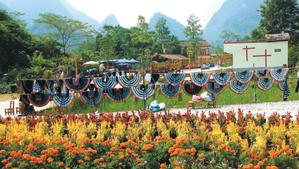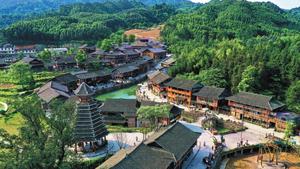Tourism improves rural livelihoods throughout the country, Yang Feiyue reports.
 Geyasi Valley in Guangxi's Nandan county has evolved into a resort featuring pastoral scenes and ethnic elements. (PHOTO PROVIDED TO CHINA DAILY)
Geyasi Valley in Guangxi's Nandan county has evolved into a resort featuring pastoral scenes and ethnic elements. (PHOTO PROVIDED TO CHINA DAILY)
Pan Jiehui resumed his daily routine at the Shuanglonggou scenic spot in southern China's Guangxi Zhuang autonomous region in late February.
The attraction was one of the first to reopen since the novel coronavirus outbreak. It has since offered free tickets to encourage visits.
Pan cleans the grounds and tends a vegetable garden every morning before visitors arrive. He has worked at the scenic spot since 2017.
"I only had odd jobs before. The income was barely enough to make ends meet," Pan says.
He and his wife have had steady pay since they started at Shuanglonggou.
She makes ethnic Miao embroidery at a workshop in the scenic spot in the daytime, and her completed artworks are sold to visitors.
At night, the couple dons costumes and joins other staffers in a largescale performance at Shuanglonggou.
The attraction has provided them with multiple jobs and income streams, enabling them to provide a quality education for their child and have their own parents live with them.
 Tourists visit Laojundong scenic area in Rongshui Miao autonomous county in the Guangxi Zhuang autonomous region during the May Day holiday. (PHOTO / XINHUA)
Tourists visit Laojundong scenic area in Rongshui Miao autonomous county in the Guangxi Zhuang autonomous region during the May Day holiday. (PHOTO / XINHUA)
"We started a small farm, a little workshop and a mini market based on the destination's conditions," says Shuanglonggou's deputy general manager Wei Zhongping.
The farm is run by 13 rural households and satisfies their basic food needs. The workshop hires residents who've escaped poverty to make souvenirs, Wei says.
The mini market hosts distinctive eateries run by locals.
Shuanglonggou has also restored nearly 100 original stilted wooden buildings in recent years and encouraged local people living in poverty to work and live in the scenic spot.
Villagers in Geyasi Valley in Guangxi's Nandan county, a roughly four-hour drive from Shuanglonggou, are also benefiting from travelers who come to enjoy pastoral scenes and culture.
The county is home to ethnic Baiku Yao people, and Geyasi Valley has evolved into a resort featuring ethnic elements.
The resort has introduced a culture company to train local women to make such folk items as embroidery and costumes for tourists, providing jobs for local women.
 An aerial photo of Longan county in Guangxi, known for its karst landforms and picturesque scenery. (PHOTO / XINHUA)
An aerial photo of Longan county in Guangxi, known for its karst landforms and picturesque scenery. (PHOTO / XINHUA)
Other residents work as performers or run rural restaurants and guesthouses. None of the nearly 100 households live in poverty.
Tu Guofeng runs a gift shop in Tianzhushan Grand Canal in eastern China's Anhui province.
The scenic spot's waterfalls and spring blossoms attracted many tourists in March.
"The recent visits have benefited my shop," Tu tells China Tourism News.
He had fallen into poverty after a serious disease made it impossible for him to work years ago.
Locals previously relied on the bamboo trade and subsidies. Bamboo output was low, and transportation was underdeveloped.
Things changed when He Yanchang began to develop the scenic area in 2002. Over 70 households, including Tu's, are involved in tourism today.
Now, Tu can make about 20,000 yuan (US$2,824) a year without too much strenuous labor.
Residents of the Wanfo Lake scenic area, two hours' drive from Tianzhushan, in Anhui's Shucheng county have been using e-commerce and livestreaming to boost tourism.
 Villagers who sell such folk items as batik cloth in Geyasi Valley in Guangxi's Nandan county benefit from travelers who come to enjoy pastoral scenes and ethnic culture. (PHOTO PROVIDED TO CHINA DAILY)
Villagers who sell such folk items as batik cloth in Geyasi Valley in Guangxi's Nandan county benefit from travelers who come to enjoy pastoral scenes and ethnic culture. (PHOTO PROVIDED TO CHINA DAILY)
The attraction recently gave away 3,000 free tickets during a livestream on Douyin, also known as TikTok. Travelers quickly snatched them up.
The Wanfo Lake Resort has been involving local farmers in the travel business since 1995.
Over 500 villagers around the lake play roles in the scenic spot's operations, which provides each with more than 3,000 yuan a year in extra income, Shucheng county's government says.
During a recent TikTok stream, county head Zhang Xiuping promoted the local tea oil festival and farm produce when marketing Wanfo Lake tourism. This generated over 7.5 million yuan in sales.
In eastern China's Fujian province, the Tulou scenic spot has built e-commerce platforms to market products made by local villagers.
At present, the attraction's management has brought together over 200 rural households in over 50 villages in Yongding district and helped them sell over 70 products nationwide, including vegetables, poultry, meat, honey and grain.
 Shuanglonggou scenic spot in Guangxi features traditional stilted wooden buildings. (PHOTO PROVIDED TO CHINA DAILY)
Shuanglonggou scenic spot in Guangxi features traditional stilted wooden buildings. (PHOTO PROVIDED TO CHINA DAILY)
More than 100,000 residents' livelihoods are connected to tourism, Yongding's government says.
The district received over 11.8 million visits in 2019, generating 13.5 billion yuan.
Binglanggu Resort in Baoting Li and Miao autonomous county in southern China's Hainan province has been using local ethnic-culture tourism to improve residents' lives.
The resort has invested over 6 million in a street with over 100 booths selling local foods and folk art.
Over 1,500 locals near Binglanggu earn livings through tourism.
The resort has also founded a rural-homestay cooperative to involve villagers.
Contact the writer at yangfeiyue@chinadaily.com.cn


